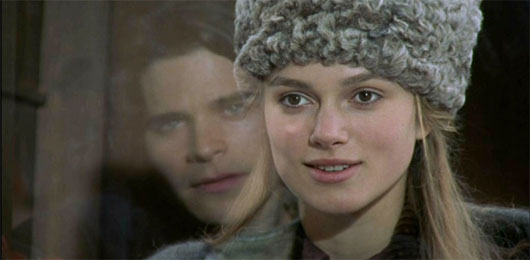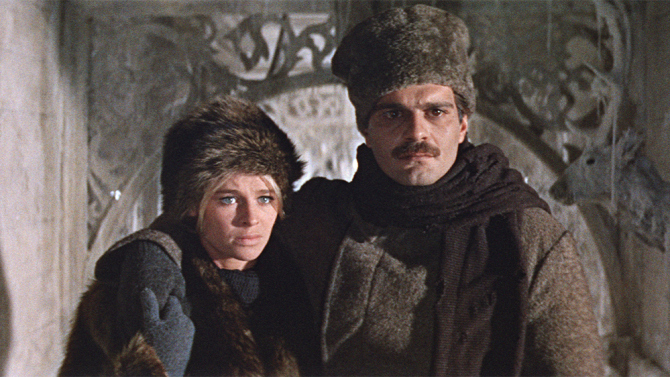 |
| Move over Julie Christie... |
Remakes
are often derided as unoriginal and unnecessary efforts that
undermine the very qualities that made an original film a classic.
With the plethora of films that remake everything from sitcoms, to
children’s shows, to video games which are regularly released to
reviews that are mixed at best, it is easy to see how remakes have
been stereotyped as shorthand for ‘not worth your ticket’. In
some cases, however, a remake can provide a fresh look at material in
a way that makes an old story relevant for a whole new generation. In
such instances, a remake can provide additional insight that enriches
the viewing experience for fans of the original film, while still
holding resonance for new viewers. This week’s review will explore
three films that will have you rethinking the reputation of the
remake.
 |
| Don't look now, but we just got outdone |
Doctor
Zhivago: Like
its predecessor, this 2002 BBC miniseries follows the tumultuous romance
of poet and doctor, Yuri Zhivago, and his tormented nurse and muse, Lara
Antipova, amidst the upheaval and turmoil of the Russian Revolution.
While the 1965 adaptation of the Boris Pasternak novel is rightly
regarded as a classic, the more recent adaptation brings the novel to
life with a grittiness and realism that highlights the tragedy of the
lovers’ doomed affair as well as that of the world that is
crumbling all around them. For example, the miniseries utilizes
actual newsreel footage from World War I and the early days of the
Soviet Union to place the events portrayed on screen within the
context of Russian history. The miniseries also utilizes location
shots, as well as authentic Russian music and historically accurate
costumes that bring the distant world of the characters to vibrant
life. Beyond the aesthetics, the film also utilizes a miniseries
length script that allows the characters time to evolve and adds
additional insight into each character's backstory. For example,
while the 1965 film portrayed Lara’s (Julie Christie in the 1965 film and Keira Knightley in the miniseries) affair with her mother’s
lover, Victor Komarovsky (Rod Steiger and Sam Neill ), as a mercenary attempt to escape her
impoverished existence, the miniseries accurately portrays the
relationship to be one of sexual abuse. The miniseries adds further
insight into Lara’s mentality by portraying her relationship with
her mother (Adrienne Corri and Maryam d'Abo), who encourages Komarovsky’s abuse in an effort to
ensure he continues providing them financial support. Through this
emphasis upon her formative years, the film offers a more complex
perspective of its heroine that portrays her as a resilient woman struggling
with the guilt and shame commonly experienced by abuse victims, rather than an opportunistic femme
fatale. Similarly, the film contains several flashbacks to Yuri’s (Omar Sharif and Hans Matheson) childhood that highlight Komarovsky’s role in his father’s
suicide. These flashbacks further emphasize Komarovsky's cunning and lend credibility to Yuri’s otherwise confounding
refusal to accept Komarovsky’s help in escaping the Soviet Union in
the film’s tragic final act. The film also successfully imbues
Lara’s boy next door boyfriend turned ruthless commissar husband,
Pasha (Tom Courtenay and Kris Marshall), and Yuri’s adopted sister turned wife, Tonia (Geraldine Chaplin and Alexandra Maria Lara), with much
needed depth by portraying them as three dimensional people worthy of the audience’s sympathy. In this way, the audience remains fully aware
of the ramifications of Yuri and Lara’s affair, even while rooting
for the pair to find happiness. Thus, while less glamorous than its
predecessor, the BBC miniseries of Doctor
Zhivago
relays all the romance and tragedy of the original novel with a truly
epic scope.
 |
| Damn that Bergman and Boyer! |
Gaslight:
Originally
adapted from the stage hit Angel
Street,
Gaslight
is unique example in which each adaptation only seems to make the
story that much more thrilling. While the 1940 British adaptation and
the 1944 Hollywood adaptation both follow the basic plot of Angel
Street,
the Hollywood treatment made this beloved thriller a genre staple
that has since entered the realm of popular vernacular. In both
stories, a naïve newlywed is systematically driven insane by her
manipulative husband as part of his scheme to cover up his past
crimes and regain a lost fortune. In the original film, Bella (Diana Wynyard) is a
starry-eyed bride who blindly follows her husband’s orders in
accordance with the norms of Edwardian London. In the 1944 film,
Paula (Ingrid Bergman) is a vivacious, but haunted woman whose past is marked by
tragedy following the death of her parents and later the gruesome
murder of her aunt. While Paula does play a secondary role in her
relationship with her husband, her submissiveness is due the fact
that unlike Bella she is entering her marriage in a foreign country
whose customs she is unfamiliar with, and is married to a much older man
who in many ways fills the void of her lost family. As a result,
Paula is a heroine audiences empathize with, and eventually root for
as she finally takes steps to reclaim her life. Bella, by contrast,
is unreasonably meek to the point of appearing childlike and offers
virtually no resistance against her husband’s machinations, leaving
audiences wondering if there really might be some merit to her
husband’s accusations of mental illness after all. Similarly, in
the 1940 film Paul (Anton Walbrook) is a volatile man who continuously belittles Bella
when he isn’t engaging in adulterous affairs with both prostitutes
and the household maid. Paul’s one-dimensional villainy leaves
viewers baffled as to what made Bella fall in love with him and what
it is that maintains her blind faith in both him and their marriage.
In the 1944 film, however, viewers follow Paula and Gregory (Charles Boyer) on their
whirlwind courtship and witness the passion and charm
that first draws her to him. Even after the couple settle into their
new home and Gregory sets his malicious plans in motion, Charles
Boyer continues to infuse the role with a sly humor and smooth charm
that provide viewers with necessary insight into Paula’s continued
trust in and attraction to him. The role of the persevering police
officer (Frank Pettingrell in the 1940 film and Joseph Cotton in the 1944 remake) who solves the central mystery is also given greater weight
and a backstory in the 1944 version, making him more than merely a necessary
plot device. Finally, the final reveal contains greater shock value
in the 1944 version by tying Paula’s tortured present directly to
her troubled past in a way that is never forced and remains
satisfying. In short, as both a mystery and a psychological study of
an abusive relationship, the 1940 adaptation does not hold a candle
to its 1944 successor.
_02.jpg) |
| The days before divorce was an option... |
 |
| Say hello... |
Scarface:
The
image of Al Pacino as Tony Montana brandishing a tommy-gun and shouting “Say hello
to my little friend” is so ingrained in popular culture that many
viewers have forgotten that the 1983 gangland classic is actually a
remake. Written as a combination of a 1930’s take on the Borgia’s
and a thinly veiled portrait of notorious Chicago gangster Al Capone,
Scarface
was first released in 1932. In the first version, Tony Camonte (Paul Muni) is a
brutish rising gangster in 1930’s Chicago who makes his way to the
top of the illegal liquor trade, leaving chaos in his wake. The 1983
film updates the well-worn mafia angle to 1980’s Miami amidst the
backdrop of the Cuban immigration wave. The 1983 film, remains
surprisingly faithful to its predecessor by incorporating both Tony’s
pursuit of his boss’ haughty mob moll (Karen Morely in the 1932 film and Michelle Pfeiffer in the 1983 update) and his protective
relationship with his younger sister (Anne Dvorak and Mary Elizabeth Mastrontonio), which borders on incestuous,
into his bloody rise to power. The ways in which the remake bests the
original are almost entirely due to its updated setting. While
numerous films and television series have been set in the treacherous
world of prohibition era organized crime, films about the emerging
drug trade were cutting edge at the time of the 1983 film’s
release, which ensured that the remake would carry all of the shock
and cautionary warnings of the original, while still drawing in a new
generation. This updated setting also provided an excellent
opportunity for the thriller to serve double duty as social
commentary with Tony arriving in America only to fall fast and hard
for all of the excesses of the 1980’s high life. The inclusion of
Tony’s backstory as a Cuban refugee was a particularly inspired addition as it provided viewers with insight into the oppression and
trauma that made Tony the ruthless man that he is, while his efforts
to embrace American capitalism provide an apt motive for his eventual
entrance into the drug trade. This added dimension to Tony’s
history makes him more than just another screen criminal and instead
reveals him to be, much like Michael Corleone and Jay Gatsby before
him, an American Dreamer led brutally and tragically astray. While
both versions of the lurid tale offer their own thrills, for a modern
take on the classic gangster genre look no further than 1983’s
Scarface.
 |
| To my little friend! |



_02.jpg)



Thanks for poosting this
ReplyDelete